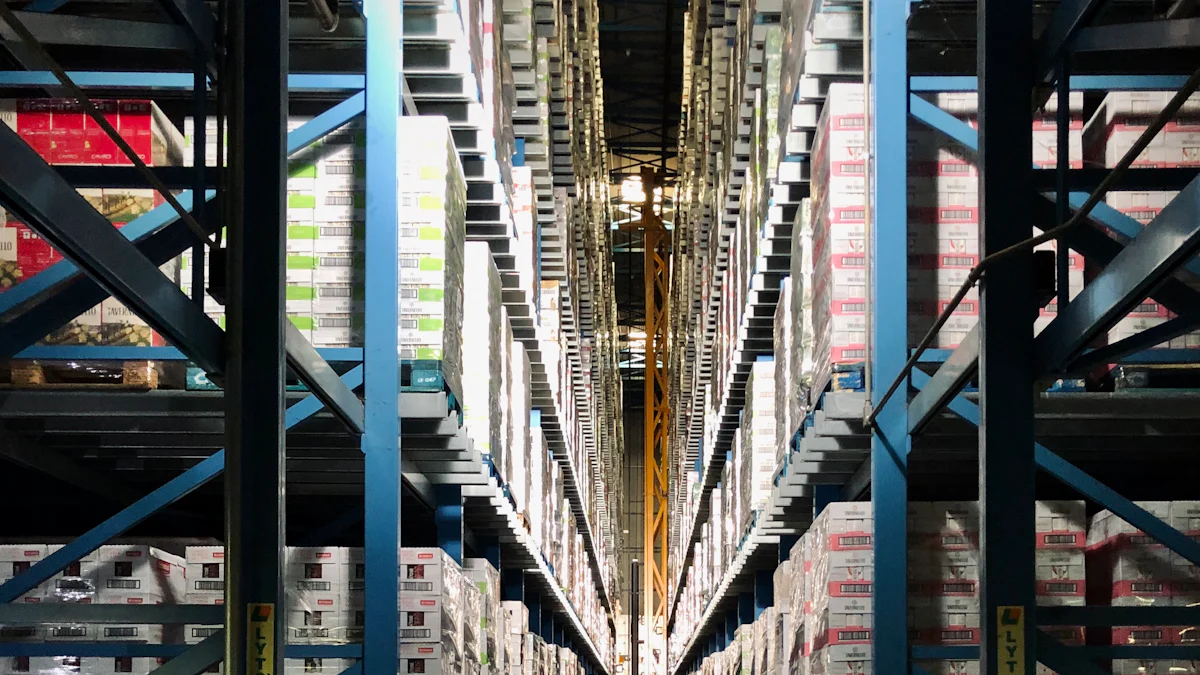A Comprehensive Guide to Supply Chain Platforms

Supply chain platforms play a pivotal role in modern business operations, offering a centralized view of the supply chain that enhances efficiency and transparency. The evolution of technology within supply chain management has been transformative, revolutionizing industries and streamlining processes. With cloud computing adoption on the rise and digital ecosystems expected to expand significantly by 2025, the integration of advanced supply chain platforms is becoming increasingly essential for businesses to thrive.
Understanding Supply Chain Platforms
Supply chain platforms serve as the backbone of modern businesses, providing a centralized hub for overseeing and optimizing supply chain activities. These platforms offer a comprehensive view of the entire supply chain process, facilitating seamless coordination and enhancing operational efficiency.
What are Supply Chain Platforms?
Definition and Overview
A digital supply chain platform is a sophisticated technology solution designed to streamline end-to-end supply chain operations within a unified framework. It acts as a single source of truth, enabling businesses to manage various aspects such as procurement, production, and distribution effectively. By integrating critical functions like integration, operations, and distribution, these platforms enhance visibility and operational agility.
Key Components
The key components of supply chain platforms include advanced data analytics capabilities, real-time monitoring tools, collaborative interfaces, and intelligent automation features. These components work in harmony to optimize processes, improve decision-making accuracy, and drive overall supply chain performance.
Evolution of Supply Chain Technology
Historical Perspective
Over the years, supply chain technology has evolved significantly from traditional manual processes to sophisticated digital solutions. The historical perspective showcases a gradual shift towards automation, digitization, and integration across supply chain functions. This transformation has been instrumental in enhancing productivity, reducing lead times, and mitigating operational risks.
Modern Developments
In the contemporary landscape, modern supply chain technology emphasizes connectivity, scalability, and adaptability. With the advent of cloud computing, big data analytics, Internet of Things (IoT), and artificial intelligence (AI), supply chain platforms have become more robust and agile than ever before. These developments empower businesses to respond swiftly to market dynamics, optimize resource utilization, and deliver superior customer experiences.
Common Problems in Supply Chain Management
Inefficiencies and Bottlenecks
Causes of Inefficiencies
Lack of streamlined processes leading to delays in production schedules.
Poor inventory management resulting in stockouts or overstock situations.
Manual data entry errors causing inaccuracies in order fulfillment.
Inadequate communication between departments leading to misaligned objectives.
Impact on Business Operations
Increased operational costs due to inefficiencies in resource allocation.
Delayed order processing affecting customer satisfaction and retention.
Reduced productivity levels among employees due to repetitive manual tasks.
Higher chances of supply chain disruptions impacting overall business continuity.
Lack of Visibility and Transparency
Challenges in Tracking and Monitoring
Limited real-time visibility into inventory levels across multiple locations.
Inefficient monitoring of shipment statuses and delivery timelines.
Difficulty in identifying bottlenecks within the supply chain process promptly.
Lack of transparency regarding supplier performance metrics and quality standards.
Consequences for Stakeholders
Decreased trust between partners due to a lack of shared information.
Higher risks of counterfeit products entering the supply chain unnoticed.
Compliance issues arising from inadequate tracking of regulatory requirements.
Potential financial losses from inefficiencies that go undetected.
Role and Types of Supply Chain Technology

Supply chain technology plays a crucial role in enhancing operational efficiency and accuracy within supply chain management processes. By leveraging advanced digital solutions, businesses can streamline their operations, optimize resource allocation, and improve overall performance.
Role of Technology in Supply Chain Management
Enhancing Efficiency
Implementing supply chain platforms such as Digital Supply Chain Platform enables organizations to automate manual tasks, reduce lead times, and enhance productivity. These platforms provide real-time insights into supply chain activities, allowing for proactive decision-making and efficient process optimization.
Improving Accuracy
Utilizing cutting-edge technologies like Blue Yonder enhances data accuracy and visibility across the entire supply chain. By centralizing information flow and integrating diverse functions, businesses can minimize errors, mitigate risks, and ensure seamless coordination among stakeholders.
Types of Supply Chain Platforms
Enterprise Resource Planning (ERP) Systems
ERP systems like SAP S/4HANA offer comprehensive solutions for managing core business processes such as finance, HR, procurement, and inventory. These platforms integrate various functions to streamline operations and facilitate data-driven decision-making.
Transportation Management Systems (TMS)
TMS solutions, including Oracle Transportation Management, focus on optimizing transportation operations by enhancing route planning, load optimization, and carrier management. These platforms enable businesses to reduce shipping costs, improve delivery times, and enhance customer satisfaction.
Warehouse Management Systems (WMS)
WMS software, such as HighJump Warehouse Advantage, provides end-to-end visibility into warehouse operations by automating tasks like inventory tracking, order fulfillment, and labor management. These platforms optimize warehouse efficiency, minimize stockouts, and ensure accurate order processing.
Supply Chain Planning (SCP) Software
SCP tools like Kinaxis RapidResponse enable organizations to create agile supply chain plans by integrating demand forecasting, inventory optimization, and production scheduling. These platforms help businesses adapt to market changes quickly, reduce excess inventory levels, and enhance supply chain resilience.
JUSDA's JusLink: The Intelligent Supply Chain System
JusLink, an innovative platform from JUSDA Supply Chain Management International Co., Ltd., offers real-time visibility into supply chain activities through advanced analytics and collaboration features. This intelligent system streamlines end-to-end processes while fostering seamless communication among stakeholders.
JUSDA's JusTrade: Simplifying International Trade
JusTrade simplifies international trade procedures by providing a unified platform for customs clearance, taxation compliance, and logistics coordination. This platform reduces trade complexities for import-export enterprises while ensuring regulatory compliance and cost efficiency.
JUSDA SR: Empowering Cross-Border Retail
JUSDA SR focuses on empowering cross-border retail operations by offering tailored logistics services for e-commerce merchants. With specialized express lines and warehousing solutions across borders,
JUSDA's Cloud Warehouse: Integrated Storage Solutions
The Cloud Warehouse service from JUSDA provides integrated storage solutions with automated warehousing capabilities powered by big data analytics. This service optimizes inventory management processes,
Benefits of Supply Chain Platforms

Operational Efficiency
Streamlining Processes
Implementing supply chain platforms like Digital Supply Chain Platform enables organizations to automate manual tasks, reduce lead times, and enhance productivity. These platforms provide real-time insights into supply chain activities, allowing for proactive decision-making and efficient process optimization.
Reducing Costs
Utilizing cutting-edge technologies such as Cloud Computing and Storage minimizes operational expenses by optimizing resource allocation and inventory management. By leveraging cloud-based solutions, businesses can achieve cost efficiencies while maintaining high levels of service quality.
Enhanced Visibility and Transparency
Real-time Data Access
Access to real-time data through advanced supply chain platforms enhances decision-making accuracy and operational responsiveness. With comprehensive visibility into supply chain activities, organizations can proactively address issues, track performance metrics, and ensure seamless operations.
Improved Decision Making
Leveraging data analytics tools embedded in NetSuite enables businesses to make informed decisions based on predictive insights and market trends. By analyzing historical data and forecasting future demand patterns, organizations can optimize inventory levels, reduce stockouts, and enhance overall supply chain efficiency.
Better Collaboration
Integration with Partners
Supply chain platforms facilitate seamless collaboration with partners by providing a centralized platform for communication, order management, and data sharing. By integrating external stakeholders into the supply chain ecosystem, businesses can streamline processes, improve coordination, and enhance overall supply chain performance.
Communication Improvements
Enhanced communication tools within Logility Digital Supply Chain Platform enable efficient information exchange among internal teams and external partners. By fostering transparent communication channels, organizations can mitigate risks, resolve issues promptly, and maintain strong relationships across the supply chain network.
Choosing the Right Supply Chain Platform
Assessing Business Needs
Identifying Key Requirements
Evaluate the specific needs of your business to determine the essential features required for efficient supply chain management.
Identify key areas that need improvement, such as inventory control, order processing, or communication channels.
Consider scalability and adaptability as crucial factors when assessing your business requirements.
Evaluating Current Systems
Assess your existing supply chain systems to identify gaps and inefficiencies that hinder operational excellence.
Review the performance of current platforms in terms of data accuracy, process automation, and integration capabilities.
Determine whether your current systems align with industry best practices and technological advancements.
Key Features to Look For
Scalability
Prioritize scalability when selecting a supply chain platform to ensure it can grow alongside your business needs.
Look for platforms that offer flexible configurations, modular expansions, and seamless integration with third-party applications.
Consider future growth projections and choose a scalable solution that can accommodate evolving supply chain demands.
User-Friendliness
Opt for user-friendly supply chain platforms that are intuitive and easy to navigate for all stakeholders.
Ensure that the platform provides a simple interface with clear functionalities to enhance user adoption and productivity.
Select platforms with robust training resources and customer support to facilitate smooth onboarding processes.
Integration Capabilities
Choose a supply chain platform with strong integration capabilities to connect seamlessly with other enterprise systems.
Prioritize platforms that support API integrations, data synchronization, and interoperability with third-party tools.
Evaluate the platform's ability to integrate with existing ERP systems, CRM software, and e-commerce platforms for comprehensive data exchange.
Vendor Evaluation and Selection
Researching Vendors
Conduct thorough research on potential vendors to understand their reputation, expertise, and track record in supply chain technology.
Explore vendor websites, case studies, and customer testimonials to gauge their industry experience and solution offerings.
Seek recommendations from industry peers or consult online reviews to assess vendor credibility and service quality.
Comparing Offerings
Compare the features, functionalities, and pricing models of different supply chain vendors to identify the best fit for your business requirements.
Create a detailed comparison chart highlighting key aspects such as scalability options, customization capabilities, and post-implementation support services.
Request product demonstrations or trials from shortlisted vendors to experience firsthand how their solutions align with your operational needs.
Seeking References and Reviews
Reach out to existing customers of potential vendors to gather insights on their experiences with the supply chain platforms.
Request references from vendors for direct feedback on implementation timelines, system performance, and customer service responsiveness.
Browse independent review sites or forums for unbiased opinions on vendor solutions' strengths, weaknesses, and overall satisfaction levels.
Supply chain leaders face the critical decision of choosing between ERP systems and digital platforms to manage supply chains efficiently. While both options streamline operations, it's essential to consider key factors before making a choice. Digital supply chain platforms offer agility and resilience, providing real-time insights for confident decision-making. By leveraging advanced technologies like JUSDA's solutions, businesses can enhance operational efficiency and stay ahead in the dynamic market landscape. Embrace innovation, assess your needs, and unlock the potential of cutting-edge supply chain technology for sustainable growth.
See Also
Exploring Sustainable Transport Solutions for Efficient Supply Chains
Navigating Supply Chain Challenges: An In-Depth Guide
Revolutionizing Industries with Cloud-Based Supply Chain Solutions
Transforming Supply Chain Management with Cloud Solutions
Embracing Cutting-Edge Transport Technology for Supply Chain Success
